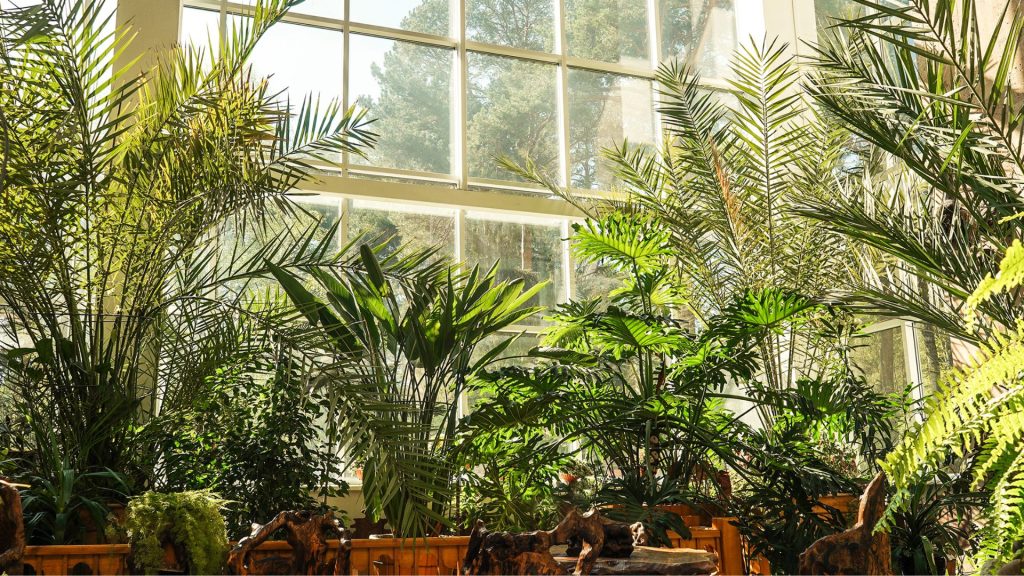It is no surprise that the purchase of indoor palm tree is on the rise. These alluring plants have such variety they are bound to be a beautiful inclusion in your home décor. But with so many types of indoor palm plants out there, how can you know which one is right for you?
Benefits of Keeping a Palm Plant Indoors
Keeping a palm plant indoors can provide several benefits, including:
- Improving air quality: Palm plants are known to improve indoor air quality by removing harmful pollutants such as benzene, formaldehyde, and xylene from the air.
- Increasing humidity: By releasing moisture through transpiration, palm plants can help to increase the humidity levels in a room, which can be especially beneficial during the dry winter months.
- Aesthetic appeal: With their tropical appearance, palm plants can add a touch of greenery and natural beauty to any indoor space.
- Stress relief: Studies have shown that having plants in the home can have a calming effect on the mind and reduce stress levels.
- Easy maintenance: Many species of indoor palms are low-maintenance and easy to care for, making them a great option for those who don’t have a lot of time or experience with gardening.
- Versatility: Indoor palm plants come in a variety of sizes and shapes, making them suitable for any size room or style of decor.
Types of Palm Plants Suitable for Indoor Growing
Below are 7 of the best indoor palms, including helpful advice on how to take care of indoor palm trees, to make your decision easier:
1. Cascade Palm
The Cascade Palm, also known as the Neanthe Bella Palm or Parlor Palm, is a species of indoor palm plant that is native to Central America. It is a popular choice for indoor gardening due to its compact size and tolerance for low light conditions. The Cascade Palm has delicate, feathery fronds that give it a graceful, elegant appearance, and it grows to be between 2-6 feet tall.
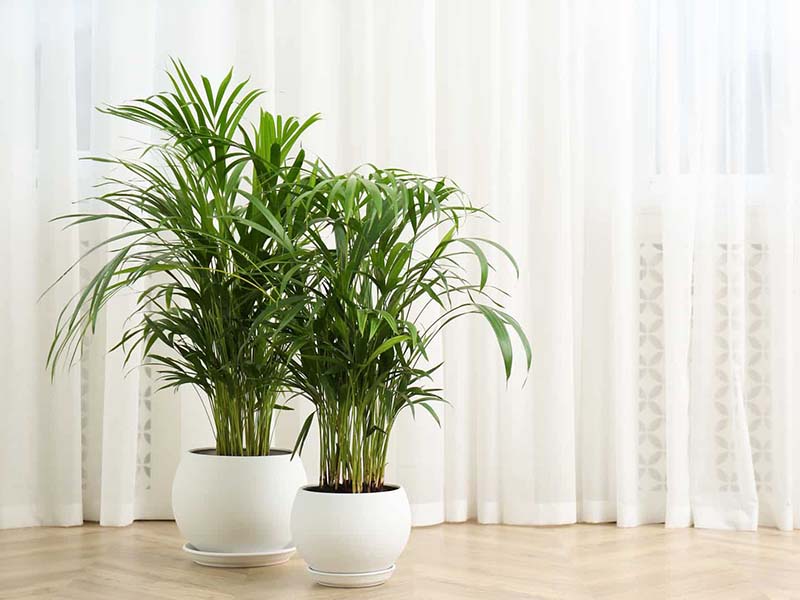
To care for a Cascade Palm, provide it with bright, indirect light and water when the top inch of soil is dry. Maintain a consistent temperature between 65-85°F and keep humidity levels high, as palms prefer a humid environment. Regular misting or using a humidifier can help with this. Additionally, it’s important to fertilize your Cascade Palm every 2-3 months with a balanced fertilizer.
- Common Names: Chamaedorea Cataractarum; The Cat Palm; Cataract Palm.
- Origin: Southern Mexico and Central America.
- Visual Features: Sleek, dark-green leaves on thin shoots.
- Ideal Indoor Conditions: Like many other types of indoor palm plants, the cascade palm can survive in softer light conditions; a partial shade, or filtered light.
- Growth: Cascade palms can reach up to 2 meters tall.
- Water: Regular watering 1-2 times per week — when the soil’s surface starts to dry.
2. Yucca Palm
The Yucca Palm, also known as the Spanish Bayonet, is a species of indoor palm plant that is native to the deserts of the southwestern United States and northern Mexico. It is a hardy and low-maintenance plant that is well-suited for indoor gardening. The Yucca Palm has stiff, sword-like leaves that grow to be 2-3 feet long and it can grow to be 4-8 feet tall.
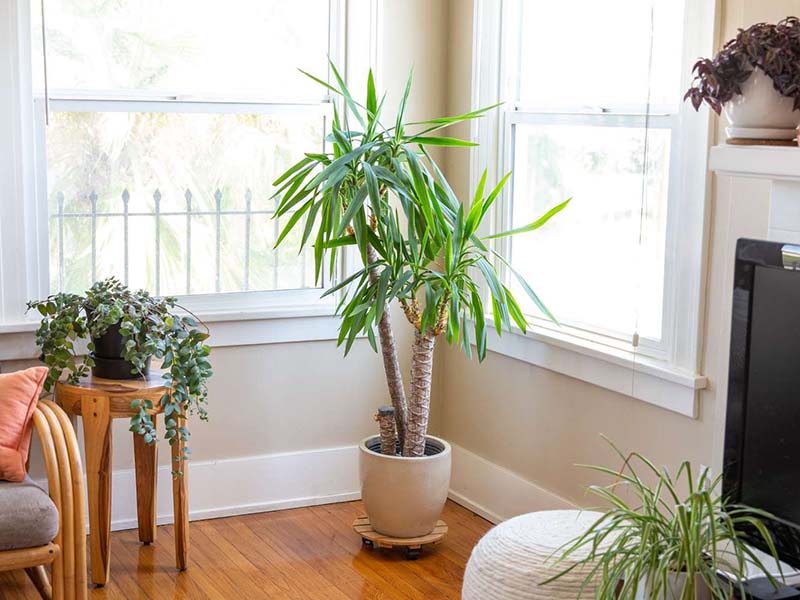
To care for a Yucca Palm, provide it with bright, direct light and allow the soil to dry out between waterings. Yucca Palms can tolerate a wide range of temperatures and do not require high humidity levels. They are also relatively drought-tolerant and can go long periods without water. It’s important to avoid overwatering, as too much moisture can cause root rot. Additionally, the sharp leaves of the Yucca Palm can be potentially dangerous, so it is important to place it in a location where it won’t be bumped or touched.
- Common Names: Yucca Elephantipes; Stick Yucca; Spineless Yucca.
- Origin: Mexico and Guatemala
- Visual Features: Wide, sword-shaped leaves with a slight arch and pointed ends.
- Ideal Indoor Conditions: Placed by a South facing window, providing as much light as possible.
- Growth: Slow growth reaching up to 4.5meters after many years.
- Water: Like many indoor palm tree varieties, watering once a week and allowing the soil to dry out a little should keep it growing steadily.
3. Kentia Palm
The Kentia Palm, also known as the Paradise Palm or Sentry Palm, is a species of indoor palm plant that is native to Lord Howe Island off the east coast of Australia. It is a slow-growing plant that is prized for its elegant, graceful appearance and tolerance for low light conditions. The Kentia Palm has feathery fronds that can grow to be 5-6 feet long and it can grow to be 6-12 feet tall.
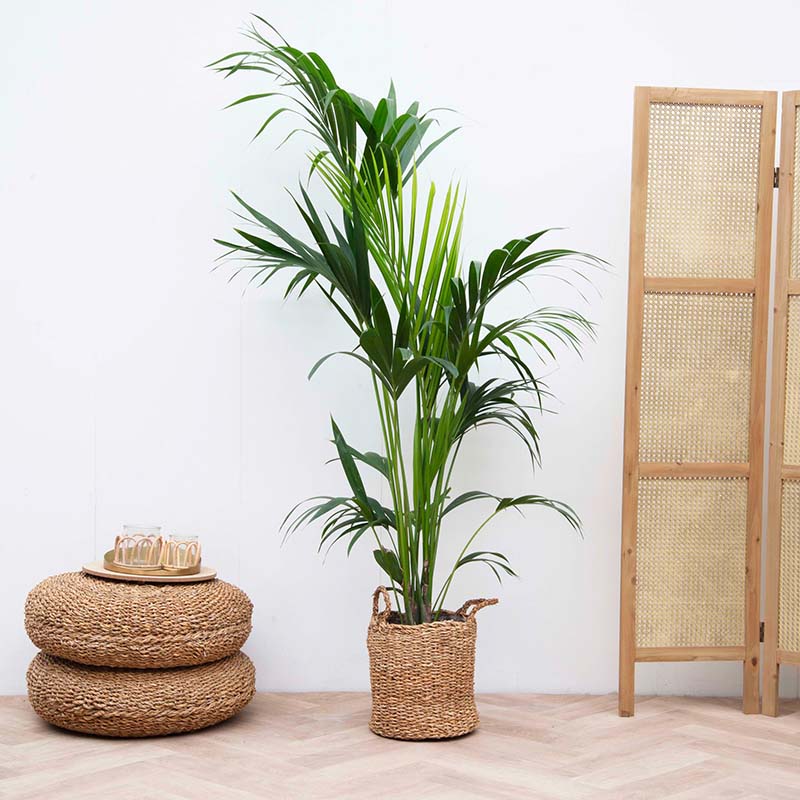
To care for a Kentia Palm, provide it with bright, indirect light and water when the top inch of soil is dry. Maintain a consistent temperature between 65-85°F and keep humidity levels moderate, as Kentia Palms prefer a humid but not overly moist environment. Regular misting or using a humidifier can help with this. Additionally, it’s important to fertilize your Kentia Palm every 2-3 months with a balanced fertilizer. The Kentia Palm is also relatively low-maintenance and is not prone to pests or disease.
- Common Names: Howea Forsteriana; Thatch Palm.
- Origin: Lord Howe Island, Australia.
- Visual Features: Slender trunk with a graceful crown of dark green drooping fronds.
- Ideal Indoor Conditions: Preferably an area that receives indirect light, however, will tolerate very minimal lighting conditions.
- Growth: Contrary to other indoor houseplants, the kentia palm- similar to other palm tree varieties- has slow growth and reaches up to 4meters indoors.
- Water: Water only when the top inch (2.5 cm) of the soil starts to dry out.
4. Parlor Palm
The Parlor Palm, also known as the Neanthe Bella Palm or Cascade Palm, is a species of indoor palm plant that is native to Central America. It is a popular choice for indoor gardening due to its compact size and tolerance for low light conditions. The Parlor Palm has delicate, feathery fronds that give it a graceful, elegant appearance, and it grows to be between 2-6 feet tall.
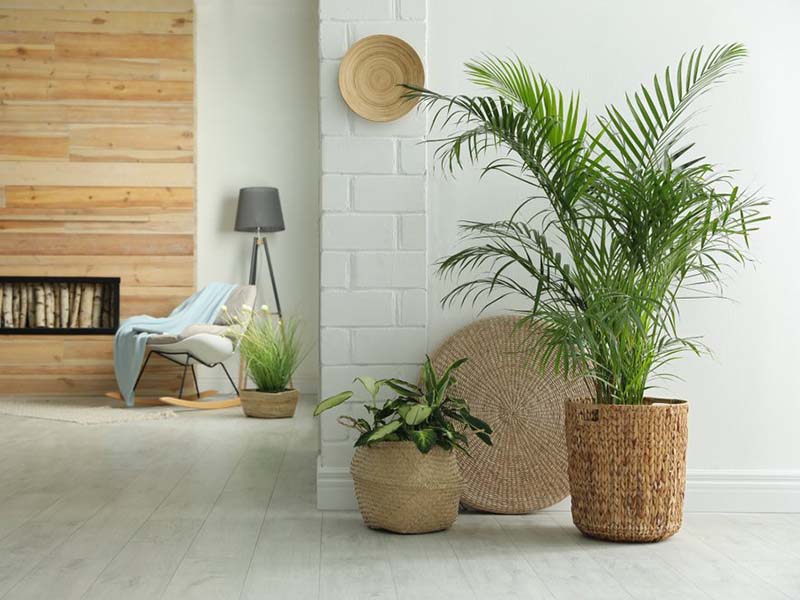
To care for a Parlor Palm, provide it with bright, indirect light and water when the top inch of soil is dry. Maintain a consistent temperature between 65-85°F and keep humidity levels high, as palms prefer a humid environment. Regular misting or using a humidifier can help with this. Additionally, it’s important to fertilize your Parlor Palm every 2-3 months with a balanced fertilizer.
- Common Names: Chamaedorea Elegans; The Neanthe Bella Palm.
- Origin: Rainforests in Southern Mexico and Guatemala
- Visual Features: Slender green trunk with punctured, crescent-shaped leaves.
- Ideal Indoor Conditions: Unlike other types of indoor palm trees, the parlor palm actually prefers less light. So, keep it away from windows that receive direct sunlight throughout the day.
- Growth: Very slow growth reaching 2meters tall.
- Water: Water sparingly, allow the soil to dry out a little between watering.
5. Pygmy Date Palm
The Pygmy Date Palm, also known as the Dwarf Date Palm, is a species of indoor palm plant that is native to the deserts of northern Africa and the Middle East. It is a slow-growing plant that is prized for its compact size and its tropical, date-palm appearance. The Pygmy Date Palm has feathery fronds that can grow to be 2-3 feet long and it can grow to be 6-12 feet tall.
To care for a Pygmy Date Palm, provide it with bright, indirect light and water when the top inch of soil is dry. Maintain a consistent temperature between 65-85°F and keep humidity levels moderate, as Pygmy Date Palms prefer a humid but not overly moist environment. Regular misting or using a humidifier can help with this. Additionally, it’s important to fertilize your Pygmy Date Palm every 2-3 months with a balanced fertilizer. The Pygmy Date Palm is also relatively low-maintenance and is not prone to pests or disease.
- Common Names: Phoenix Roebelenii; Miniature Date Palm; Robellini.
- Origin: South East Asia, South West China, Northern Laos, and Northern Vietnam.
- Visual Features: Yellow-green hue; thin trunk with dark green fronds forming a crown.
- Ideal Indoor Conditions: Lower light levels coupled with low humidity.
- Growth: Up to 3meters tall.
- Water: To stop this indoor palm tree dying, maintain a regular watering schedule, and use well-draining soil.
6. Ponytail Palm
The Ponytail Palm, also known as the Bottle Palm or Elephant Foot Tree, is a species of indoor palm plant that is native to Mexico. It is a distinctive plant that is easily recognizable by its bulbous trunk and long, slender fronds that resemble a ponytail. The Ponytail Palm is a slow-growing plant that can grow to be 5-10 feet tall. To care for a Ponytail Palm, provide it with bright, indirect light and water deeply when the soil is dry.

The plant is tolerant of a wide range of temperatures and is relatively drought-tolerant, but it is important to avoid overwatering, as too much moisture can cause root rot. Additionally, the Ponytail Palm has a large, water-storing trunk, which makes it a great choice for low-light conditions or for use in rooms with little natural light. No fertilization is required for Ponytail Palms, but they may benefit from occasional light feedings during the growing season.
- Common Names: Beaucarnea Recurvata; The Elephant’s Foot.
- Origin: Eastern Mexico
- Visual Features: Sleek bulb-like trunk with long curly leaves mimicking a ponytail.
- Ideal Indoor Conditions: Bright light at least half of the time.
- Growth: Up to 4.72 meters.
- Water: As the Ponytail Palm is not technically a type of indoor palm and is in fact a succulent, you should let the soil dry out significantly between watering.
7. Bamboo Palm
The Bamboo Palm, also known as the Reed Palm or Clustered Fishtail Palm, is a species of indoor palm plant that is native to southern Mexico and Central America. It is a popular choice for indoor gardening due to its graceful, tropical appearance and tolerance for low light conditions. The Bamboo Palm has long, slender fronds that can grow to be 3-6 feet long and it can grow to be 4-12 feet tall.
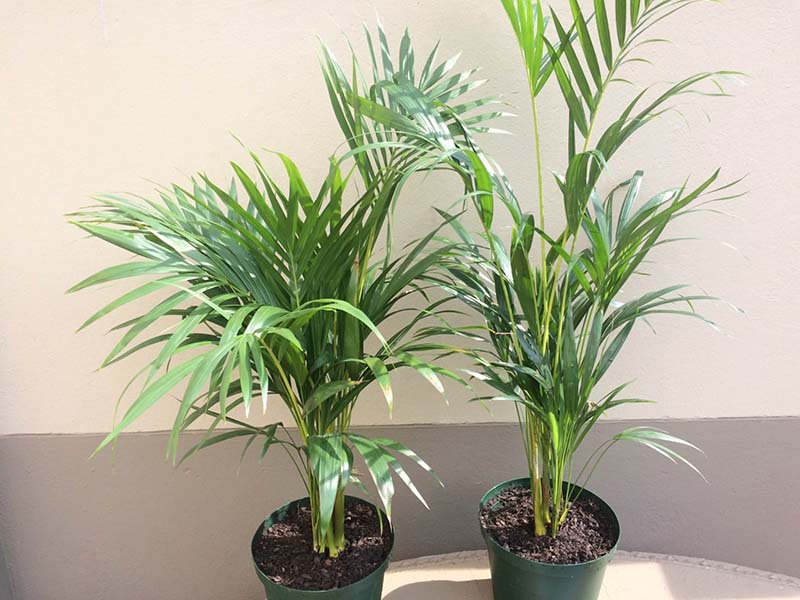
To care for a Bamboo Palm, provide it with bright, indirect light and water when the top inch of soil is dry. Maintain a consistent temperature between 65-85°F and keep humidity levels high, as palms prefer a humid environment. Regular misting or using a humidifier can help with this. Additionally, it’s important to fertilize your Bamboo Palm every 2-3 months with a balanced fertilizer. The Bamboo Palm is also relatively low-maintenance and is not prone to pests or disease.
- Common Names: Dypsis Lutescens; Areca Palm; Butterfly Palm.
- Origin: Madagascar
- Visual Features: Many stems each with long foliage positioned in an upward curve.
- Ideal Indoor Conditions: Will survive with minimal light, but will grow taller in brighter conditions.
- Growth: Between 1 m-3.5meters.
- Water: Water only when the soil surface feels dry, ensure the use of well-draining soil.
Conclusion
Now you’re one step closer to adorning your interior with beautiful, tropical houseplants, it is important to pay attention to how to take care of your indoor palm trees.
There are so many indoor palm tree varieties that it will come as no surprise to realize the needs of these species are equally diverse.
Indoor palm tree care is an essential part of growing the best indoor palm plant. Knowing the growth habits, fertilizer needs, and how much light your indoor houseplants require are all vital to stop your indoor palm tree from dying.
Most types of indoor palm trees have tropical origins, so it is easy to assume plenty of sunlight and water is enough to help them flourish. But some indoor palm tree varieties will drown from too much water and others can survive with minimal light or even shaded conditions. That being said, all different types of indoor palm require some light. They cannot survive in complete darkness.
Growing indoor palm trees is a highly rewarding activity- if you take good care of your indoor palm, you may even see the leaves reaching as high as your ceiling.
Indoor palm plants are an excellent way to bring the outdoors inside. With the vastly different types of indoor palm trees available, it is an exciting way to start your very own house palm collection.
Paying special attention to research your particular species of indoor palm is imperative to ensure successful growth and will allow you to provide the best indoor palm tree care.


